PONTIAC GRAND PRIX 2001 User Guide
Manufacturer: PONTIAC, Model Year: 2001, Model line: GRAND PRIX, Model: PONTIAC GRAND PRIX 2001Pages: 373, PDF Size: 2.81 MB
Page 11 of 373

ix
For example,
these symbols
are used on an
original battery:
CAUTION
POSSIBLE
INJURY
PROTECT
EYES BY
SHIELDING
CAUSTIC
BATTERY
ACID COULD
CAUSE
BURNS
AVOID
SPARKS OR
FLAMES
SPARK OR
FLAME
COULD
EXPLODE
BATTERY
These symbols
are important for
you and your
passengers
whenever your
vehicle is driven:
CHILD
RESTRAINT
TOP STRAP
ANCHOR
DOOR LOCK
UNLOCK
FASTEN
SEAT
BELTS
POWER
WINDOW
AIR BAG
These symbols
have to do with
your lamps:
MASTER
LIGHTING
SWITCH
TURN
SIGNALS
PARKING
LAMPS
HAZARD
WARNING
FLASHER
DAYTIME
RUNNING
LAMPS
FOG LAMPS
These symbols
are on some of
your controls:
WINDSHIELD
WIPER
WINDSHIELD
WASHER
WINDSHIELD
DEFROSTER
REAR
WINDOW
DEFOGGER
VENTILATING
FAN
These symbols
are used on
warning and
indicator lights:
ENGINE
COOLANT
TEMP
BATTERY
CHARGING
SYSTEM
BRAKE
COOLANT
ENGINE OIL
PRESSURE
ANTI-LOCK
BRAKES
Here are some
other symbols
you may see:
FUSE
LIGHTER
HORN
FUEL
Vehicle Symbols
These are some of the symbols you may find on your vehicle. Also see ªWarning Lights and Gagesº in the Index.
Page 12 of 373
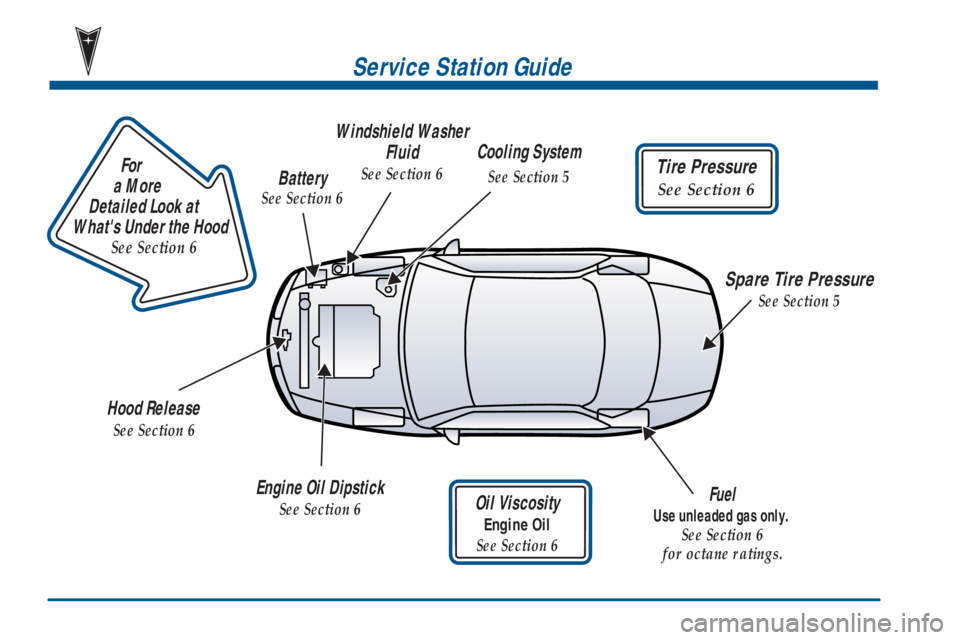
For
a More
Detailed Look at
What's Under the Hood
See Section 6
Tire Pressure
See Section 6
Service Station Guide
Oil Viscosity
Engine Oil
See Section 6
Engine Oil Dipstick
See Section 6Fuel
Use unleaded gas only.
See Section 6
for octane ratings.
Cooling System
See Section 5
Hood Release
See Section 6
Windshield Washer
Fluid
See Section 6
Spare Tire Pressure
See Section 5
Battery
See Section 6
Page 13 of 373
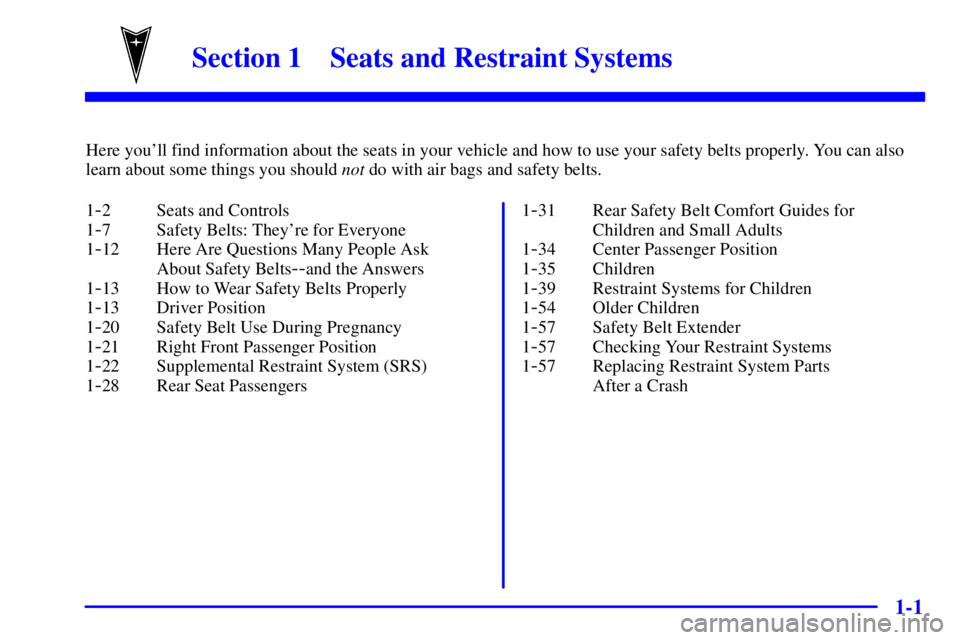
1-
1-1
Section 1 Seats and Restraint Systems
Here you'll find information about the seats in your vehicle and how to use your safety belts properly. You can also
learn about some things you should not do with air bags and safety belts.
1
-2 Seats and Controls
1
-7 Safety Belts: They're for Everyone
1
-12 Here Are Questions Many People Ask
About Safety Belts
--and the Answers
1
-13 How to Wear Safety Belts Properly
1
-13 Driver Position
1
-20 Safety Belt Use During Pregnancy
1
-21 Right Front Passenger Position
1
-22 Supplemental Restraint System (SRS)
1
-28 Rear Seat Passengers1
-31 Rear Safety Belt Comfort Guides for
Children and Small Adults
1
-34 Center Passenger Position
1
-35 Children
1
-39 Restraint Systems for Children
1
-54 Older Children
1
-57 Safety Belt Extender
1
-57 Checking Your Restraint Systems
1
-57 Replacing Restraint System Parts
After a Crash
Page 14 of 373
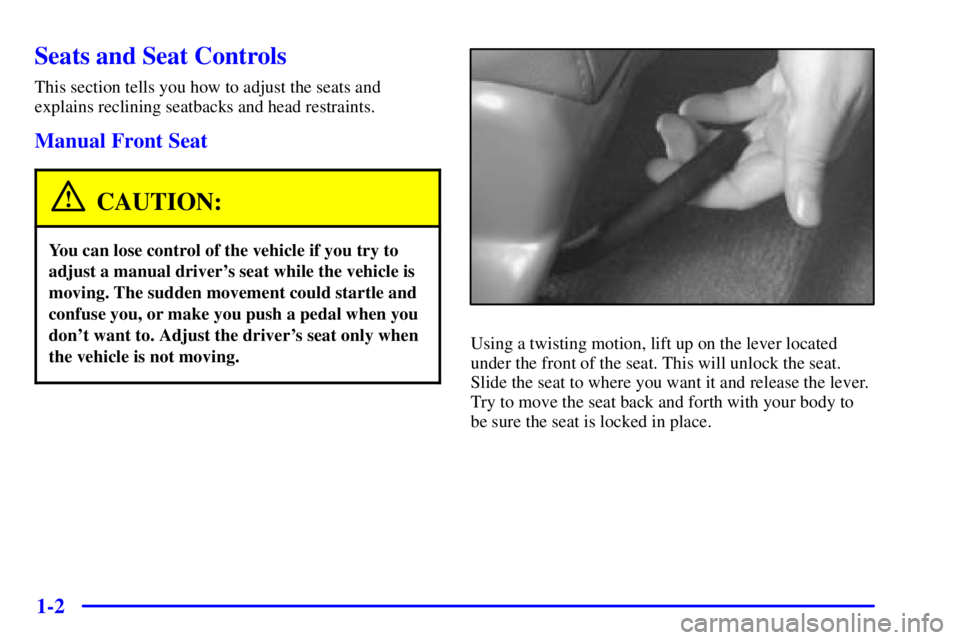
1-2
Seats and Seat Controls
This section tells you how to adjust the seats and
explains reclining seatbacks and head restraints.
Manual Front Seat
CAUTION:
You can lose control of the vehicle if you try to
adjust a manual driver's seat while the vehicle is
moving. The sudden movement could startle and
confuse you, or make you push a pedal when you
don't want to. Adjust the driver's seat only when
the vehicle is not moving.
Using a twisting motion, lift up on the lever located
under the front of the seat. This will unlock the seat.
Slide the seat to where you want it and release the lever.
Try to move the seat back and forth with your body to
be sure the seat is locked in place.
Page 15 of 373

1-3 6-Way Power Driver's Seat (If Equipped)
This switch is designed to
control the movements of
your seat cushion. It is
located on the outboard side
of the driver's seat cushion.
To move the seat forward or rearward, slide the switch
forward or rearward. To raise or lower the seat, push the
switch up or down. To raise or lower the front portion of
your seat, push the front of the switch up or down. To
raise or lower the rear portion of your seat, push the rear
of the switch up or down.
4-Way Power Lumbar Driver's
Seat (Option)
If your vehicle has this feature, there will be a switch
located on the outboard side of the driver's seat cushion,
in front of the reclining seatback lever. To increase or
decrease lumbar support, push the switch forward or
rearward. To adjust the lumbar support up or down, push
the switch up or down.
Page 16 of 373
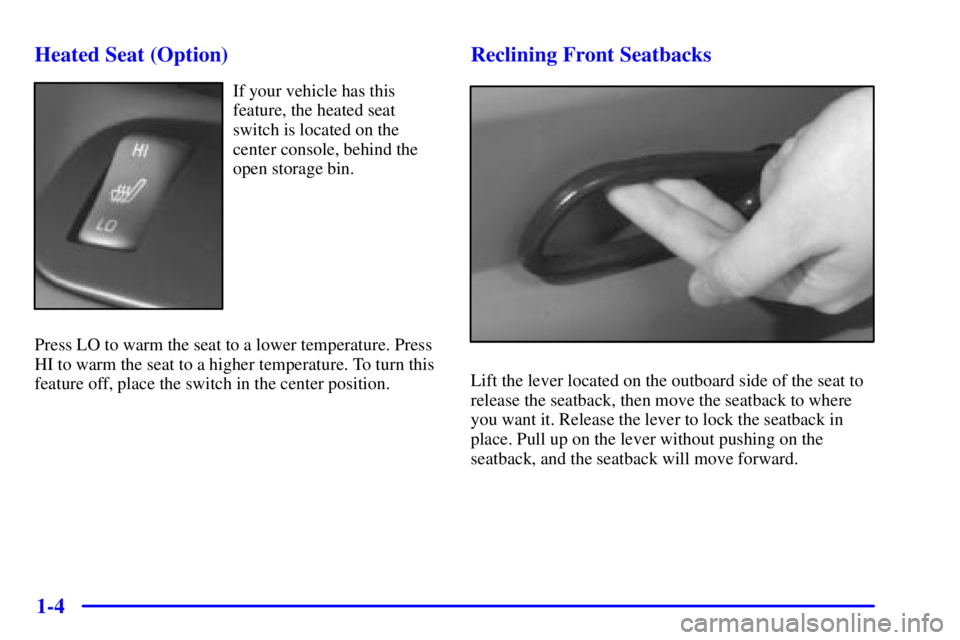
1-4 Heated Seat (Option)
If your vehicle has this
feature, the heated seat
switch is located on the
center console, behind the
open storage bin.
Press LO to warm the seat to a lower temperature. Press
HI to warm the seat to a higher temperature. To turn this
feature off, place the switch in the center position.
Reclining Front Seatbacks
Lift the lever located on the outboard side of the seat to
release the seatback, then move the seatback to where
you want it. Release the lever to lock the seatback in
place. Pull up on the lever without pushing on the
seatback, and the seatback will move forward.
Page 17 of 373
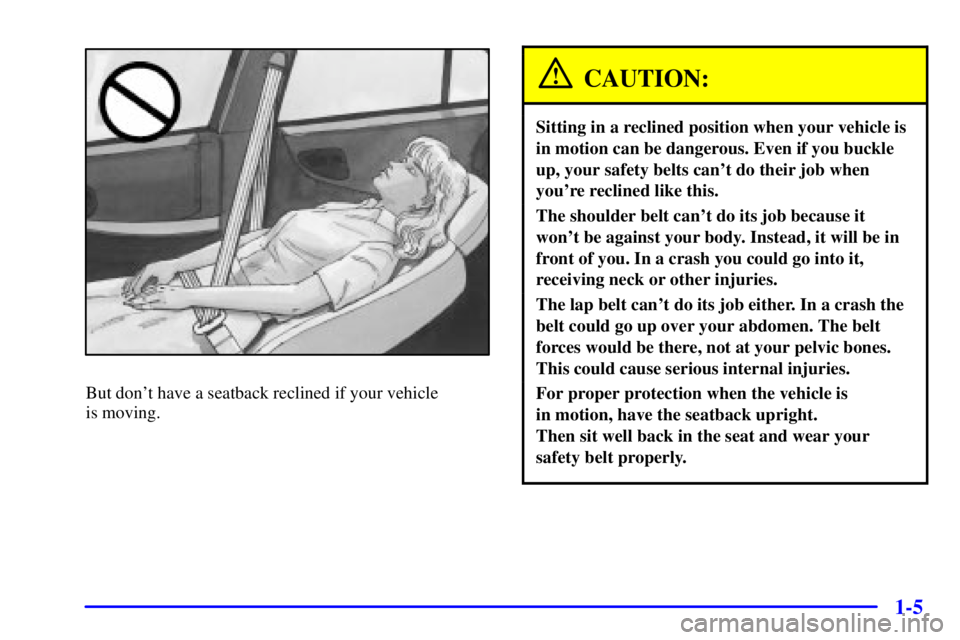
1-5
But don't have a seatback reclined if your vehicle
is moving.
CAUTION:
Sitting in a reclined position when your vehicle is
in motion can be dangerous. Even if you buckle
up, your safety belts can't do their job when
you're reclined like this.
The shoulder belt can't do its job because it
won't be against your body. Instead, it will be in
front of you. In a crash you could go into it,
receiving neck or other injuries.
The lap belt can't do its job either. In a crash the
belt could go up over your abdomen. The belt
forces would be there, not at your pelvic bones.
This could cause serious internal injuries.
For proper protection when the vehicle is
in motion, have the seatback upright.
Then sit well back in the seat and wear your
safety belt properly.
Page 18 of 373
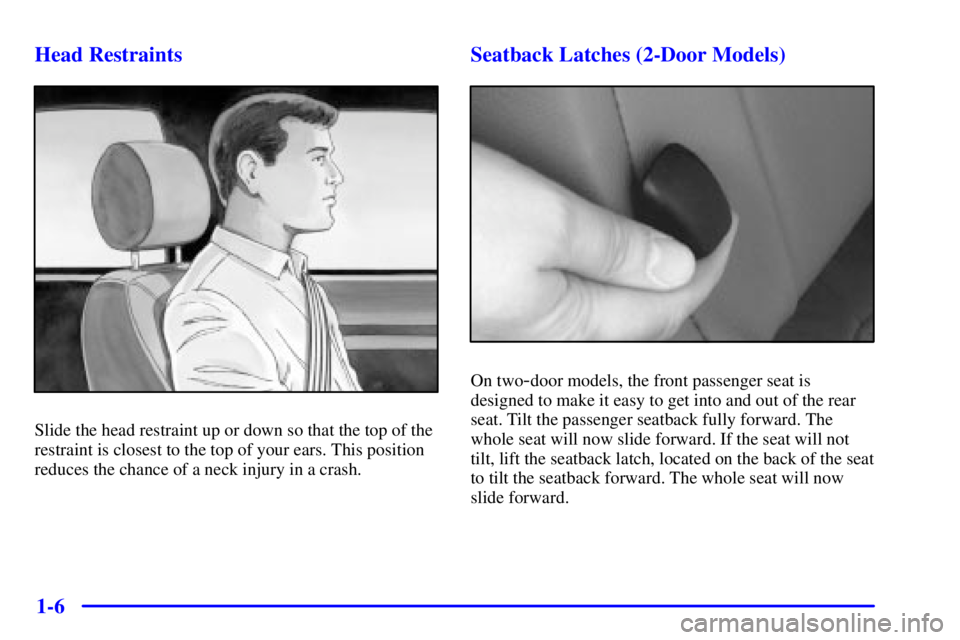
1-6 Head Restraints
Slide the head restraint up or down so that the top of the
restraint is closest to the top of your ears. This position
reduces the chance of a neck injury in a crash.
Seatback Latches (2-Door Models)
On two-door models, the front passenger seat is
designed to make it easy to get into and out of the rear
seat. Tilt the passenger seatback fully forward. The
whole seat will now slide forward. If the seat will not
tilt, lift the seatback latch, located on the back of the seat
to tilt the seatback forward. The whole seat will now
slide forward.
Page 19 of 373
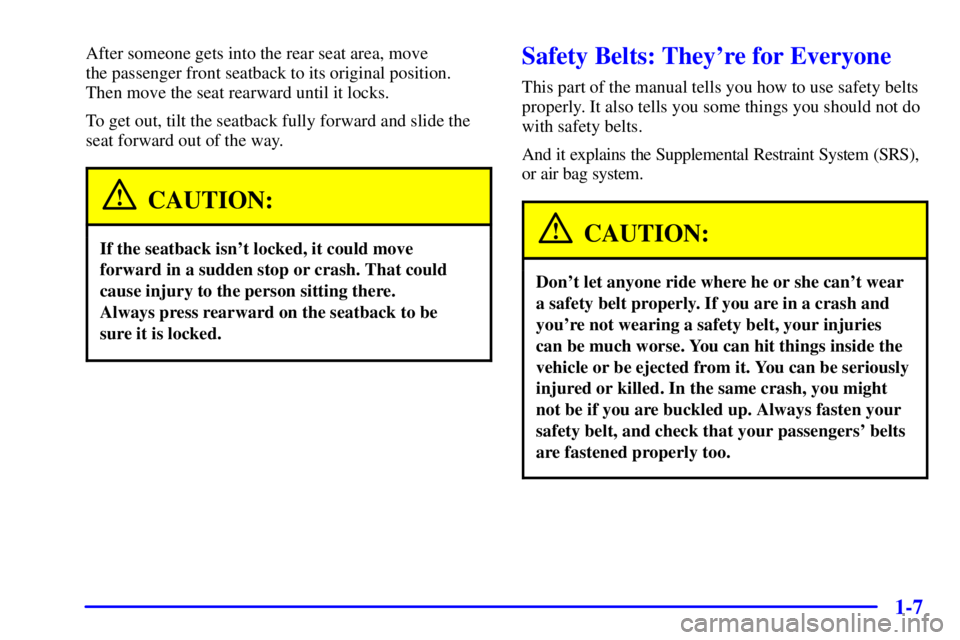
1-7
After someone gets into the rear seat area, move
the passenger front seatback to its original position.
Then move the seat rearward until it locks.
To get out, tilt the seatback fully forward and slide the
seat forward out of the way.
CAUTION:
If the seatback isn't locked, it could move
forward in a sudden stop or crash. That could
cause injury to the person sitting there.
Always press rearward on the seatback to be
sure it is locked.
Safety Belts: They're for Everyone
This part of the manual tells you how to use safety belts
properly. It also tells you some things you should not do
with safety belts.
And it explains the Supplemental Restraint System (SRS),
or air bag system.
CAUTION:
Don't let anyone ride where he or she can't wear
a safety belt properly. If you are in a crash and
you're not wearing a safety belt, your injuries
can be much worse. You can hit things inside the
vehicle or be ejected from it. You can be seriously
injured or killed. In the same crash, you might
not be if you are buckled up. Always fasten your
safety belt, and check that your passengers' belts
are fastened properly too.
Page 20 of 373

1-8
CAUTION:
It is extremely dangerous to ride in a cargo area,
inside or outside of a vehicle. In a collision,
people riding in these areas are more likely to be
seriously injured or killed. Do not allow people to
ride in any area of your vehicle that is not
equipped with seats and safety belts. Be sure
everyone in your vehicle is in a seat and using a
safety belt properly.
Your vehicle has a light that
comes on as a reminder to
buckle up. See ªSafety Belt
Reminder Lightº in
the Index.In most states and Canadian provinces, the law says to
wear safety belts. Here's why: They work.
You never know if you'll be in a crash. If you do have a
crash, you don't know if it will be a bad one.
A few crashes are mild, and some crashes can be so
serious that even buckled up a person wouldn't survive.
But most crashes are in between. In many of them,
people who buckle up can survive and sometimes walk
away. Without belts they could have been badly hurt
or killed.
After more than 30 years of safety belts in vehicles, the
facts are clear. In most crashes buckling up does
matter ... a lot!